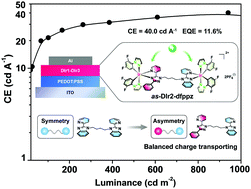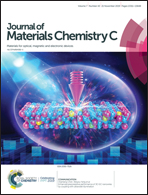Dinuclear Ir(iii) complexes with asymmetrical bridging ligands as highly efficient phosphors for single-layer electroluminescent devices†
Abstract
Dinuclear Ir(III) complexes have recently emerged with great promise for organic electroluminescent devices owing to their unique merits such as increased spin–orbit coupling and adjustable photophysical properties. However, most of them require sophisticated doping processes for their engineering, resulting in high production costs. Herein, we developed novel dinuclear Ir(III) complexes, which become weak phosphors in solution but exhibit intensified emission in the solid state. The intermolecular interaction-caused quenching was suppressed perfectly, and the carrier transport abilities were modulated simultaneously, leading to high emission efficiencies in the neat film and balanced charge carrier transport. The green-emitting single-layer nondoped device achieved promising efficiencies with an external quantum efficiency (EQE) of 11.6% and current efficiency (CE) of 40.0 cd A−1. The orange-emitting device realized an EQE of 12.9% and CE of 38.4 cd A−1, which are the highest efficiencies reported to date for solution-processed single-layer nondoped devices and even comparable to that of most reported multilayer doping devices.



 Please wait while we load your content...
Please wait while we load your content...